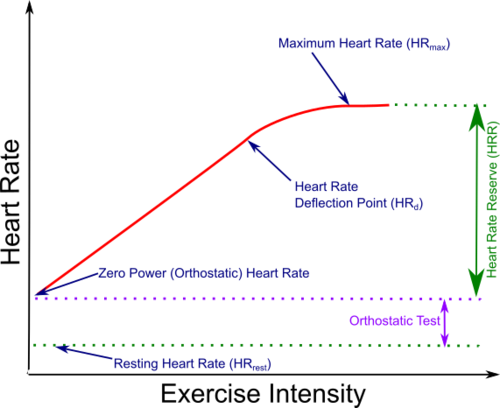Difference between revisions of "Resting Heart Rate"
User:Fellrnr (User talk:Fellrnr | contribs) (Created page with "A simplified chart of heart rate against exercise intensity showing [[Maximum Heart Rate, Heart Rate Reserve, [[Resting Hea...") |
User:Fellrnr (User talk:Fellrnr | contribs) m |
||
| Line 1: | Line 1: | ||
[[File:HeartRateSimplified.png|right|thumb|500px|A simplified chart of heart rate against exercise intensity showing [[Maximum Heart Rate]], [[Heart Rate Reserve]], [[Resting Heart Rate]] and [[Heart Rate Deflection]].]] | [[File:HeartRateSimplified.png|right|thumb|500px|A simplified chart of heart rate against exercise intensity showing [[Maximum Heart Rate]], [[Heart Rate Reserve]], [[Resting Heart Rate]] and [[Heart Rate Deflection]].]] | ||
| − | Resting Heart Rate (HR<sub>rest</sub>) is how fast your heart beats when you are not expending any energy beyond simply being alive. Finding your HR<sub>rest</sub> is easy; just check your heart rate while sitting still or lying down. Early morning is a good time, before any exercise or taken | + | Resting Heart Rate (HR<sub>rest</sub>) is how fast your heart beats when you are not expending any energy beyond simply being alive. Finding your HR<sub>rest</sub> is easy; just check your heart rate while sitting still or lying down. Early morning is a good time, before any exercise or taken [[Caffeine]], both of which will raise your HR<sub>rest</sub>. A low HR<sub>rest</sub> is normally a sign of fitness, as endurance training tends to increase the size of your heart, and a large heart needs to beat less often to pump the same amount of blood. HR<sub>rest</sub> is used to calculate [[Heart Rate Reserve]]. (Sometimes Resting Heart Rate is called Basal Heart Rate or HR<sub>b</sub>.) |
=Measuring Resting Heart Rate= | =Measuring Resting Heart Rate= | ||
Revision as of 19:37, 16 August 2012

Resting Heart Rate (HRrest) is how fast your heart beats when you are not expending any energy beyond simply being alive. Finding your HRrest is easy; just check your heart rate while sitting still or lying down. Early morning is a good time, before any exercise or taken Caffeine, both of which will raise your HRrest. A low HRrest is normally a sign of fitness, as endurance training tends to increase the size of your heart, and a large heart needs to beat less often to pump the same amount of blood. HRrest is used to calculate Heart Rate Reserve. (Sometimes Resting Heart Rate is called Basal Heart Rate or HRb.)
1 Measuring Resting Heart Rate
It is possible to take your pulse with your finger, but most people find this tricky and inconvenient. A Heart Rate Monitor will provide an accurate and simple way of checking your heart rate, but putting one on first thing in the morning (possibly before you get out of bed) is a bit of a pain. A blood pressure meter will also record heart rate, but can be a little noisy and awkward to put on. My preferred approach is to use a simple Pulse Oximeter, which is the easiest technique.